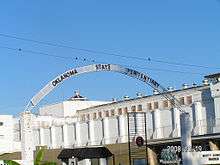Thomas J. Grasso
| Thomas J. Grasso | |
|---|---|
| Born | November 23, 1962 |
| Died |
March 20, 1995 (aged 32) Oklahoma State Penitentiary in McAlester, Oklahoma, USA |
| Citizenship | American |
| Criminal penalty |
Life imprisonment Execution by lethal injection |
| Criminal status | Executed on March 20, 1995 at Oklahoma State Penitentiary |
| Spouse(s) | Lana Grasso |
| Conviction(s) |
Robbery, First-degree murder |
Thomas J. Grasso was a 32-year-old male executed by lethal injection at Oklahoma State Penitentiary, McAlester, Oklahoma, United States, on March 20, 1995, for two murders.
He strangled Hilda Johnson, an 87-year-old woman, using her Christmas tree lights on December 24, 1990, in her Tulsa home. He stole $8 from her purse, $4 in loose change, and her television set which he sold for $125.
Six months later, after moving to New York with his wife, Lana, he murdered Leslie Holtz, an 81-year-old man from Staten Island, on July 4, 1991, stealing his Social Security check.
Arrest and conviction
New York detectives investigating the murder of Leslie Holtz arrested Grasso and within two weeks he had confessed to both murders. He first told investigators about the Staten Island killing, then about the murder of Hilda Johnson. Grasso pleaded guilty and was sentenced to 20 years to life on April 21, 1992.
The New York legislature had passed legislation which would have restored the state's death penalty, but governors Hugh Carey and Mario Cuomo, who were both morally opposed to the death penalty, vetoed the legislation.[1]
Extradition and execution
Grasso's case became an issue in George E. Pataki's gubernatorial campaign and 11 days after Pataki took office, Grasso was extradited, fulfilling the new governor's campaign pledge. Pataki and Governor Frank Keating of Oklahoma, both Republicans, signed an agreement that allowed Oklahoma correction officials to take custody of Grasso at Buffalo International Airport. Prison officials escorted him on a commercial flight to the state penitentiary at McAlester via Tulsa, on January 11, 1995.
Grasso spent his last days on the normal prison schedule, confined for 23 hours a day to his 14- by 18-foot cell in the prison's Death Row (H-unit), which he shared with 49 other condemned men. He was allowed one hour's exercise per day and three showers per week.
Final day
On the day before his execution, Grasso released four statements to the press. The first, at 3:00 p.m., read, "What we call the beginning is often the end, and to make an end is to make a beginning. The end is where we start from." The second, released at 8:25 p.m., read, "For most of us, there is only the unattended moment, the moment in and out of time. And right action is freedom from the past and future also." The first part of the second statement is a line from T.S. Elliot's "The Dry Salvages".
Shortly before 10:00 p.m., three hours before his execution time, he issued the third statement in the form of a light-hearted poem commemorating his forthcoming dispatch. The poem was entitled "A Visit with Mystery":[2]
Ready, willing and waiting am I
Asked for death but could not die
Each sunrise is one day less
I'll endure this horrible mess
As the poison drips into my veins
And from my body life does drain
I'll know then, once and for all
What "last call" means
When serving toxahol
Last meal
His last meal was two dozen steamed mussels, two dozen steamed clams (flavored by a wedge of lemon), a double cheeseburger from Burger King, a half-dozen barbecued spare ribs, two strawberry milkshakes, one-half of a pumpkin pie with whipped cream, diced strawberries, and a 16-ounce can of SpaghettiOs with meatballs, served at room temperature.
Less than an hour before he died, he issued his fourth and final statement, "I did not get my SpaghettiOs, I got spaghetti. I want the press to know this."
Execution

Just before 1:00 a.m. (EST) on March 20, 1995, Grasso walked from his cell to the execution chamber. The witnesses, including Grasso's lawyers and 12 reporters, sat in an adjoining room. About 1:00 a.m., with Grasso strapped to the gurney, warden Ron Ward picked up a phone in the witness room and spoke to Governor Keating, who granted permission to proceed from his official residence in Oklahoma City. Grasso was pronounced dead at 1:22 a.m.[3]
References
- ↑ "Governor Paterson Padlocks New York's Death Chamber". New York Observer. July 29, 2008. Retrieved December 26, 2009.
The governor opposes the death penalty, and, like former Governors Hugh Carey and Mario Cuomo, he has made a point of applying his sense of morality to questions of public policy. During the 1970s and ’80s, Mr. Carey and Mr. Cuomo annually vetoed death penalty legislation because they, like Mr. Paterson, were morally opposed to state-sponsored executions.
- ↑ A Visit with Mystery
- ↑ Schwartzman, Paul; Finnegan, Michael. "Grasso Is Put To Death Poem, Complaint His Final Words". New York Daily News. Retrieved 2011-09-15.